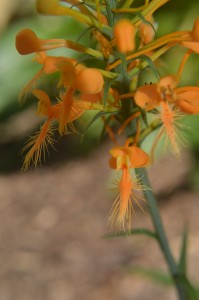I frequently have articles in the local paper about our beautiful native plants and their importance to the environment. I thought I might share a few of these, for any who might be interested, but don’t get the local paper. Here is an article I did last week on one of our native orchids.
Native Orchids
Seeing this plant for the first time in a dry patch of grass along a roadside was a jaw-dropping experience. I was enchanted, and so began my quest for the Yellow Fringed Orchid, or Platanthera cristata. After much searching, I finally am the proud owner of this most lovely of our native orchids.
Sometimes called the bog orchid, the plant grows best in moist environments, and can be found in bogs, swamps, marshes, thickets on stream borders or ponds, moist woods and prairies. One crop of the Yellow Finged orchid was found as far north as Massachusetts, although it is not clear if this colony is still there. Found in most of the Eastern United States, it is becoming rare in much of its northern range.
Numerous lance-shaped leaves are found at ground level. These lower leaves can be up to 12 inches long and 1 to 6 inches wide, while smaller leaves are found growing along the 12 inch stem up to the raceme of flowers.
The flowers of this plant are so pretty there is no way to describe them in mere words. While it’s called the Yellow Fringed Orchid, it can appear in many shades, even what I would call orange. Spikes of clustered flowers form at the top of the stem, each flower opening sequentially from bottom to top. With up to 80 blooms per stem, the bloom time can span several weeks.
I guess you could call this a pouty-looking flower because of its lower petal which droops down, giving it the look of a scolded child. This lower lip has numerous spurs giving it a fringed look. The spurs of the lower lip can be several inches long. It has a prominent anther and at least one nectar spur. In my yard this orchid is growing in a morning sun/afternoon shade area in a small container which I sunk into the ground and filled with peat moss to create a bog. The flowers were at their peak in July, even though much of the information available on this plant suggests its bloom time in the deep South is in September. Luckily, the Yellow Fringed Orchid is a perennial with a fleshy rhizomus root, which will spread over a period of time.
While the Platathera cristata may need some protection from slugs and snails in your garden, its greatest pest is humans. Roadsides where they were once common are mowed at just about the time this plant would be in bloom. Overharvesting has decimated many populations, and changes in hydrology (the water in the soil, underneath rocks and in the atmosphere) have played a part in their demise. Should you find this plant for sale, ask questions to be sure that the plants are nursery grown and not harvested from the wild.
To learn more about our beautiful native plants and how you can become a part of the solution for preserving this wonderful part of our heritage, visit the Georgia Native Plant Society web page at www.gnps.org and the West Georgia Chapter web page at www.wgawildflowers.org. Look us up on Facebook by typing in West Georgia Chapter of the Georgia Native Plant Society to follow our progress on the Buffalo Creek Nature trail restoration and to learn about upcoming meetings and workshops.
The West Georgia Chapter meets on the third Tuesday of each even numbered month, making our next meeting on October 20. We meet at the ag center in Carrollton, with meet and greet and a native plant sale at 6:30 and the program at 7:00.
But you don’t have to wait that long to get started learning more about our native plants. The WGC is hosting a workshop on native plants on Saturday, September 19 at the ag center. The doors open at 8:30 for registration. Our first presentation will be a discussion of native mushrooms and fungi. Three other sessions will focus on planting a bog garden, native ferns, and how to attract pollinators to your garden. The workshop is free. Vendors with plants, garden art and garden supplies will be on hand.

